

Occupational sitting and health risks: a syste... [Am J Prev Med. 2010. Invited Commentary: Comparing Physical Activity Across Countries—Current Strengths and Weaknesses. Physical activity is thought to be important for various health outcomes, but population levels are suspected to be low.
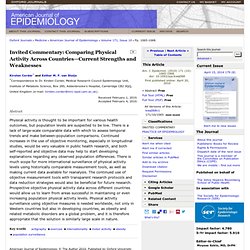
There is a lack of large-scale comparable data with which to assess temporal trends and make between-population comparisons. Continued increases in the use of objective monitoring, especially in longitudinal studies, would be very valuable in public health research, and both self-reported and objective data may help to start developing explanations regarding any observed population differences.
There is much scope for more international surveillance of physical activity levels using historically comparable measurement tools, as well as making current data available for reanalysis. The continued use of objective measurement tools with transparent research protocols and data reduction strategies would also be beneficial for future research. American Journal of Epidemiology © The Author 2010.
Are we facing a new paradigm of inactivity physiology? + Author Affiliations Correspondence to Elin Ekblom-Bak, Åstrand Laboratory of Work Physiology, Swedish School of Sport and Health Sciences, Box 5626, 114 86 Stockholm, Sweden; eline@gih.se Accepted 4 November 2009 Published Online First 4 February 2010 Evidence for the benefits of regular physical activity for several major health diseases is clear and unanimous.
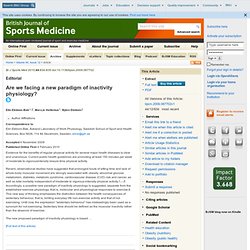
Current public health guidelines are promoting at least 150 minutes per week of moderate to vigorousintensity leisure-time physical activity. The new proposed paradigm of inactivity physiology is based … Television viewing time independently predicts all-cause and cardiovascular mortality: the EPIC Norfolk Study. Sedentary time and cardio-metabolic biomarkers in US adults: NHANES 2003–06.
A tool for measuring workers' sitting time by domain: the Workforce Sitting Questionnaire. Relationship between sedentary behaviour, physical activity, muscle quality and body composition in healthy older adults. + Author Affiliations ↵*To whom correspondence should be addressed Tel: (+44) 1413313744.
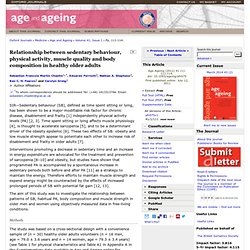
Email: sebastien.chastin@gcal.ac.uk SIR—Sedentary behaviour (SB), defined as time spent sitting or lying, has been shown to be a major modifiable risk factor for chronic disease, disablement and frailty [1] independently physical activity levels (PA) [2, 3]. Time spent sitting or lying affects muscle physiology [4], is thought to accelerate sarcopenia [5], and to be a determinant driver of the obesity epidemic [6]. These two effects of SB: obesity and low muscle strength appear to potentiate each other to increase risk of disablement and frailty in older adults [7].
The aim of this study was to investigate the relationship between patterns of SB, habitual PA, body composition and muscle strength in older men and women using objectively measured data in free-living conditions. Long-Term Sedentary Work and the Risk of Subsite-specific Colorectal Cancer. *↵Correspondence to Terry Boyle, Western Australian Institute for Medical Research, University of Western Australia, B Block, Queen Elizabeth II Medical Centre, Hospital Avenue, Nedlands, Western Australia 6009, Australia (e-mail: tboyle@waimr.uwa.edu.au).
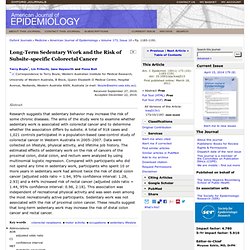
Received September 27, 2010. Accepted December 22, 2010. Research suggests that sedentary behavior may increase the risk of some chronic diseases. The aims of the study were to examine whether sedentary work is associated with colorectal cancer and to determine whether the association differs by subsite. A total of 918 cases and 1,021 controls participated in a population-based case-control study of colorectal cancer in Western Australia in 2005–2007. Abbreviations AOR adjusted odds ratio CI confidence interval MET metabolic equivalent American Journal of Epidemiology © The Author 2011.
Reducing Sedentary Behavior. A New Paradigm in Physical Activity Promotion Simon J.
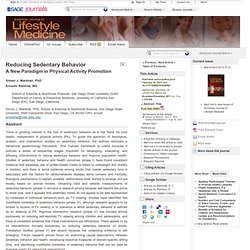
Marshall, PhD, School of Exercise & Nutritional Science, San Diego State University, 5500 Campanile Drive, San Diego, CA 92182-7251; e-mail: smarshal@mail.sdsu.edu Abstract There is growing interest in the role of sedentary behavior as a risk factor for poor health, independent of physical activity (PA). To guide the spectrum of descriptive, analytic, and intervention studies on sedentary behavior, the authors advocate a behavioral epidemiology framework.